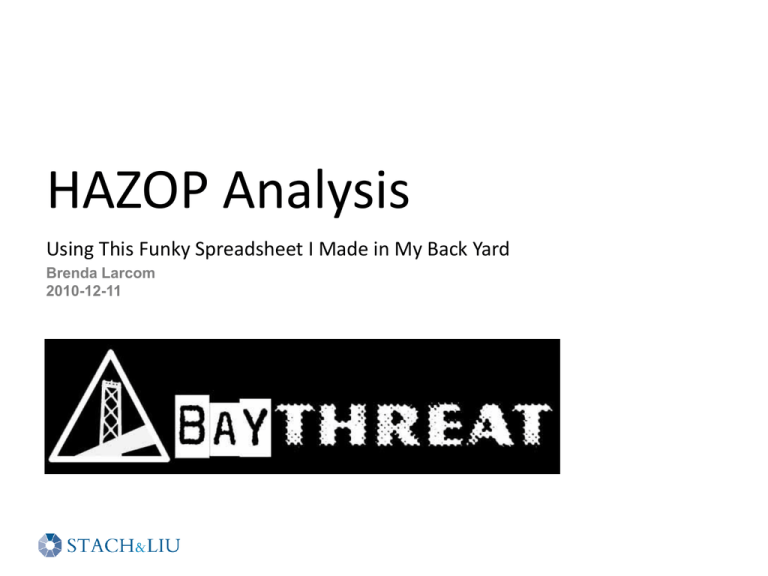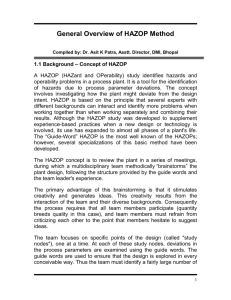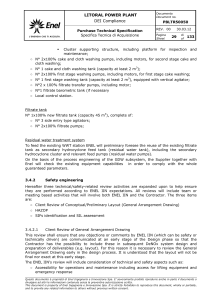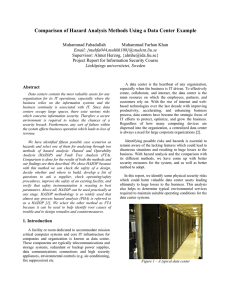Brenda Larcom 2010-12-11
advertisement

HAZOP Analysis Using This Funky Spreadsheet I Made in My Back Yard Brenda Larcom 2010-12-11 What – Overview What is HAZOP analysis? • HAZOP = Hazardous Operations • Systematic method for identifying which variations in a process need to be mitigated for safety • Repurposed for security • Partially replaces threat and attack trees • HAZOP analysis results include threat tree leaf nodes 2 What – Fair Warning What do you mean, “in your back yard”? • Very complicated spreadsheet • All formulas, no macros • Incomplete compatibility testing • Mac OS X with Excel 2008: Known good • Windows with Excel: Working, but ugly • OpenOffice and others: Please report back if you try it • No help yet • Performance issues • Recent complete rewrite 3 Where I want it now so I can play with it while you talk! • http://www.octotrike.org/ 4 Why Why is HAZOP analysis better than threat trees? • Division of labor • System analysis vs. security analysis • Effective use of minions • Quality • Experienced folks find more holes • More consistent quality • Easily reviewable • Speed • Less work to get the same results* * If you were missing more than 50% before, you will probably have to do more work. 5 How – Process Overview What do I do? • Preparation • Set security objectives (Actors, Data Model, Intended Actions, Threats, Security Objectives) • Document static architecture (e.g. data flow diagram; optional for HAZOP) • Document use case or other sequence of steps (Actors, Data Model, Use Case Details A-L) • HAZOP analysis • Vary each element of each step (Use Case Details M-P) • Analyze meaningful variations for security implications (Use Case Details Q-AE) • Use HAZOP analysis results • Plan mitigations • Plan implementation reviews 6 What – Example Overview What should it look like before I start? 7 What – Example Overview What should it look like before I start? HTTP/HTTPS over public internet, form logins Anonymous Web Server User Administrator Apache 2.0.54 on OpenBSD 3.7 with mod_lisp and CMUCL Firewall Local Filesystem PostgreSQL 8.0.3 on OpenBSD 3.7 Database ODBC over SSL on switched 100bT, user/pass login Machine Boundary Logs Flat text file on OpenBSD 3.7 8 What – Example Overview What should it look like before I start? 9 How – Varying a Step I assembled all that stuff. How do I get started? • Pick a step • Pick an element • Actor, Action, Object, or Condition? (Use Case Details M) • Pick a guide word • NO, AS WELL AS, PART OF, OTHER THAN, MORE, LESS, BEFORE, AFTER (Use Case Details N) • Figure out what this variation means, if anything • Document all meanings (Use Case Details O and P) • Productivity tips • Vary elements in the same order each time • Apply guide words in the same order each time • Vary depth-first (all guide words for one element, then all for the next element) 10 What – Example Variation How should varying a step turn out? 11 How – Analyzing a Variation I’ve got a variation. Now what? • Can this variation help an attacker? • Decide separately for each security objective (Use Case Details Q-AC) • If the variation can help an attacker, can an attacker* cause or influence it? (Use Case Details AD-AE) * Not necessarily the same attacker. Assume collaboration! • Productivity tips • Finish all variations for a step (maybe even use case) before analyzing variations 12 What – Example Analysis How should analyzing a variation turn out? 13 How – Shortcuts Isn’t that going to be awfully repetitive? • Factor common portions of use cases out into a separate use case • Don’t document variations that won’t get you anything • Variations that are equivalent to earlier variations • Variations you know are not helpful to an attacker, or not controllable by an attacker* • Claim that variations you know are pure implementation issues are not attacker-influenced * This has a reviewability penalty and may cause you to miss issues; do 3-10 use cases before you try it. 14 How – Reviewing My minion just showed up with a first draft. Now what? • Refresh your memory of the security objectives • Are variations that appear clear and meaningful? • Do all interesting variations appear? • After you have reviewed 6-12 models, save time by checking this last • Are variations that appear analyzed correctly? 15 How – Using the Results Dude, that’s a lot of data. • Plan and prioritize mitigations (Use Case Details AF-AI) • Plan implementation reviews • Security code reviews (Use Case Details some from AE, some from AG) • Security test coverage (Use Case Details some from AG) • Penetration tests (Use Case Details AD-AE, some from AF-AI) 16 Who – Contacts and Credits Where shall I send gin & tonics? • trike-devel@lists.sourceforge.net • http://www.octotrike.org/ • Trike team • Brenda Larcom • Eleanor Saitta • Academics who extended HAZOP for security, notably • Thitima Srivatanakul, John A. Clark and Fiona Polack from University of York • Our open-source-friendly employer • Stach & Liu 17











